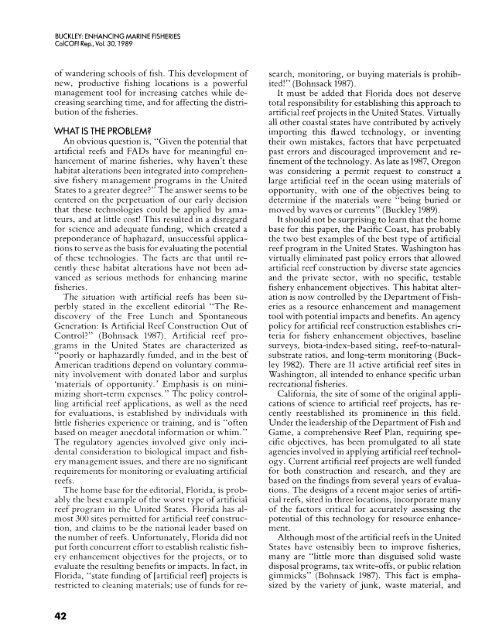CalCOFI Reports, Vol. 30, 1989 - California Cooperative Oceanic ...
CalCOFI Reports, Vol. 30, 1989 - California Cooperative Oceanic ...
CalCOFI Reports, Vol. 30, 1989 - California Cooperative Oceanic ...
Create successful ePaper yourself
Turn your PDF publications into a flip-book with our unique Google optimized e-Paper software.
BUCKLEY: ENHANCING MARINE FISHERIES<br />
ColCOFl Rep., <strong>Vol</strong>. <strong>30</strong>,<strong>1989</strong><br />
of wandering schools of fish. This development of<br />
new, productive fishing locations is a powerful<br />
management tool for increasing catches while decreasing<br />
searching time, and for affecting the distribution<br />
of the fisheries.<br />
WHAT IS THE PROBLEM<br />
An obvious question is, “Given the potential that<br />
artificial reefs and FADS have for meaningful enhancement<br />
of marine fisheries, why haven’t these<br />
habitat alterations been integrated into comprehensive<br />
fishery management programs in the United<br />
States to a greater degree” The answer seems to be<br />
centered on the perpetuation of our early decision<br />
that these technologies could be applied by amateurs,<br />
and at little cost! This resulted in a disregard<br />
for science and adequate funding, which created a<br />
preponderance of haphazard, unsuccessful applications<br />
to serve as the basis for evaluating the potential<br />
of these technologies. The facts are that until recently<br />
these habitat alterations have not been advanced<br />
as serious methods for enhancing marine<br />
fisheries.<br />
The situation with artificial reefs has been superbly<br />
stated in the excellent editorial “The Rediscovery<br />
of the Free Lunch and Spontaneous<br />
Generation: Is Artificial Reef Construction Out of<br />
Control” (Bohnsack 1987). Artificial reef pro-<br />
, grams in the United States are characterized as<br />
“poorly or haphazardly funded, and in the best of<br />
American traditions depend on voluntary conimunity<br />
involvement with donated labor and surplus<br />
‘materials of opportunity. ’ Emphasis is on niinimizing<br />
short-term expenses. ” The policy controlling<br />
artificial reef applications, as well as the need<br />
for evaluations, is established by individuals with<br />
little fisheries experience or training, and is “often<br />
based on meager anecdotal information or whim. ”<br />
The regulatory agencies involved give only incidental<br />
consideration to biological impact and fishery<br />
management issues, and there are no significant<br />
requirements for monitoring or evaluating artificial<br />
reefs.<br />
The home base for the editorial, Florida, is probably<br />
the best example of the worst type of artificial<br />
reef program in the United States. Florida has almost<br />
<strong>30</strong>0 sites permitted for artificial reef construction,<br />
and claims to be the national leader based on<br />
the number of reefs. Unfortunately, Florida did not<br />
put forth coiicurrent effort to establish realistic fishery<br />
enhancement objectives for the projects, or to<br />
evaluate the resulting benefits or impacts. In fact, in<br />
Florida, “state funding of [artificial reef] projects is<br />
restricted to cleaning materials; use of funds for re-<br />
search, monitoring, or buying materials is prohibited!”<br />
(Bohnsack 1987).<br />
It must be added that Florida does not deserve<br />
total responsibility for establishing this approach to<br />
artificial reef projects in the United States. Virtually<br />
all other coastal states have contributed by actively<br />
importing this flawed technology, or inventing<br />
their own mistakes, factors that have perpetuated<br />
past errors and discouraged improvement and refinement<br />
of the technology. As late as 1987, Oregon<br />
was considering a permit request to construct a<br />
large artificial reef in the ocean using materials of<br />
opportunity, with one of the objectives being to<br />
determine if the materials were “being buried or<br />
moved by waves or currents” (Buckley <strong>1989</strong>).<br />
It should not be surprising to learn that the home<br />
base for this paper, the Pacific Coast, has probably<br />
the two best examples of the best type of artificial<br />
reef program in the United States. Washington has<br />
virtually eliminated past policy errors that allowed<br />
artificial reef construction by diverse state agencies<br />
and the private sector, with no specific, testable<br />
fishery enhancement objectives. This habitat alteration<br />
is now controlled by the Department of Fisheries<br />
as a resource enhancement and management<br />
tool with potential impacts and benefits. An agency<br />
policy for artificial reef construction establishes criteria<br />
for fishery enhancement objectives, baseline<br />
surveys, biota-index-based siting, reef-to-naturalsubstrate<br />
ratios, and long-term monitoring (Buckley<br />
1982). There are 11 active artificial reef sites in<br />
Washington, all intended to enhance specific urban<br />
recreational fisheries.<br />
<strong>California</strong>, the site of some of the original applications<br />
of science to artificial reef projects, has recently<br />
reestablished its prominence in this field.<br />
Under the leadership of the Department of Fish and<br />
Game, a comprehensive Reef Plan, requiring specific<br />
objectives, has been promulgated to all state<br />
agencies involved in applying artificial reef technology.<br />
Current artificial reef projects are well funded<br />
for both construction and research, and they are<br />
based on the findings from several years of evaluations.<br />
The designs of a recent major series of artificial<br />
reefs, sited in three locations, incorporate many<br />
of the factors critical for accurately assessing the<br />
potential of this technology for resource enhancement.<br />
Although most of the artificial reefs in the United<br />
States have ostensibly been to improve fisheries,<br />
many are “little more than disguised solid waste<br />
disposal programs, tax write-offs, or public relation<br />
gimmicks” (Bohnsack 1987). This fact is emphasized<br />
by the variety of junk, waste material, and<br />
42















